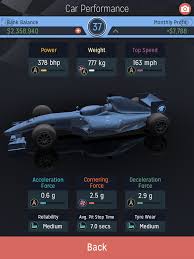The original Motorsport Manager Mobile game released back in 2014 was a fun and enjoyable experience, albeit simple and quite easy to complete. Playsport Games released a desktop version at the end of last year to much success but have returned to their roots with Motorsport Manager 2 on iOS (an Android version is due in August 2017). Have they delivered? Let’s find out.
While it is not normal to start a review talking about DLC, in this case, it is important. The game costs £3.99, but as this is an unofficial game you do not get the real-world names that you will be familiar with. Playsport has got around this with an editing tool as a DLC option. It is comparatively pricey at £6.99, and while it doesn’t change anything in terms of gameplay, if you seek authenticity then get this before you dive in.
The presentation of the game is beautiful. Whereas the first mobile game (which was played in portrait – this one is in landscape) had a more simplistic design, this feels more like a mobile version of the desktop game. While there is no formal tutorial, you do get useful information bubbles within each section of the game to help you get up to speed on how it all works together.
Starting a new career, enter your name, your team name, decide its livery colours and design, and you are the newest entry into the European Racing Series. Like the previous game and the desktop version you have three series which are the equivalent of GP3, Formula 2 and Formula 1.
There are two main elements to the game: Home and Race. Home is where you can review results, develop your cars, manage drivers and engineers, upgrade your headquarters, finance your car for the following season and decide which sponsors you will sign to help fund the expensive world of motor racing. Race is where you put your efforts from home to the test.
Throughout your career, the three championships run concurrently with each other so you can keep an eye on the best drivers as you aspire to create a team and factory that can attract the best engineers and drivers to your setup. Cars can be developed through upgrades or if you want to get an edge on the competition, you can buy items in a marketplace (note, this is using in-game money – no mini-transactions here thankfully!). You are limited on which parts of the car you can upgrade depending on what facilities your headquarters have. There is a tech-tree of 30 items you can invest in – this nicely ties in with your progression to becoming the championship winning team in the highest championship tier.
Drivers need to be paid of course, and with a global scouting tool you can try to approach the best drivers out there – but at cost. If you don’t have a competitive car though you will need to manage an emotional driver. If you are more realistic, however, you can develop an inexperienced driver through a season over six performance metrics for each driver.
Possibly the most important aspect of your team, however, are the engineers as these people will define what you bring to the track, each with their own specialisms and abilities. With all this expense, you need sponsors to fund your outfit. You have six sponsor slots – three for per-race payments and three for race performance/results.
So, car sorted it’s off to the race track. Each racing series has qualifying and a race for you to manage your on-track performance. The screen looks quite busy, but again with useful tutorial information bubbles on the first play-through makes sense of it all. To send out a driver you select a tyre type, aerodynamics and gear ratio settings. Quite basic options, but with only about 2 or 3 runs possible to get your grid placing, the game doesn’t allow for a complicated setup screen. Cars go out and the time comes up with the same white/green/purple sector indicators to tell you whether you are on a good lap or not.
Qualifying done, it is straight on to the race. There are some pre-race strategy options such as tyre type and aerodynamic setup. All being well you can predict your end result, but you have to contend with safety cars, yellow flags, changeable weather, drivers spinning and making mistakes and drive through penalties all of which put the best-made strategies out of the window. With practice (and car and factory development) however, the results eventually come and challenging for championship glory becomes reality.
What Playsport has done right this time is make a game that you cannot put down until you have achieved success. At TeamVVV we have not been able to put this down, and even writing this review has got in the way of that. You get an attachment to the drivers you are developing and when they are frustrated with poor results, there is a real sense of satisfaction when it all comes together.
But as with the first game, where is the replayability factor? Once you have won, there is nothing to motivate you to do another season. Even without an official licence, a possible sequel must include an IndyCar, WEC, MotoGP or Touring Car equivalent championships. The financial model doesn’t make sense too as there is not enough of a difference in cost in running a team in the lowest category vs. the top category.

